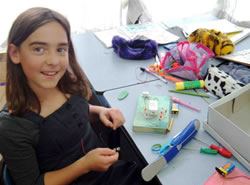Power to the people
 School: Goodwood School, Cambridge
School: Goodwood School, Cambridge
Teachers: Steve Dunsmore,
Jackie Nicholl, Robin Kateley
Year: 5/6
Area: Control and Graphics
The unit 'Power to the people: An inquiry into the nature of power generation and usage, encompassing the necessity of electricity to life in 21st century New Zealand' was developed collaboratively by the teachers of the Senior Syndicate at Goodwood School.
The unit asks students to identify and design a 'necessary' electronic device, gather the resources and the knowledge to build a model, and produce a working model of their design. It uses an inquiry model to enable students to make links across curriculum areas, particularly Social Science (access to and use of resources), Science (Physical World) and Technology (Technological Practice and Technological Knowledge).
The Technology elements provided a foundation for the unit, and were designed for three specific purposes:
- To help students recognise the rudimentary elements of a graphic design/technological process that develops an initial idea into a model or prototype for a potential product.
- To address the desire of many students, especially girls, for hands-on experience with 'real electronic components and to make real devices' for a specific purpose that they have identified.
- To give teachers a way to explore the nature and language of the Technology curriculum in The New Zealand Curriculum (2007).
In developing the unit, advisers from Waikato School Support Services were brought in to upskill some staff and to support others with less confidence to 'attack an unknown area of curriculum'. Initial discussions with advisers began in 2008 and, following Ministry of Education directives, concentrated on the Technological Practice strand, although aspects from the two new strands were also covered (Technological Knowledge and Nature of Technology). Teachers were introduced to Techlink, and given an understanding of the vital importance of Technology education processes to their inquiry approach. They then passed this knowledge and understanding on to their EHSAS (Extending High Standards Across Schools) cluster colleagues.
The three classes, working occasionally with Technology advisers from Waikato School Support Services, were first introduced to Technological Practice and how to use graphics when planning. Then, beginning with an identified need for a device, students began gathering the resources and acquiring the knowledge to build a model (Planning for Practice), instigated an iterative design process (Brief Development), which lead them to a demonstration and evaluation of their product (Outcome Development/Evaluation).
As part of the inquiry immersion process, the classes visited Karapiro Dam on the Waikato, conducted toy surveys and explored the notion of 'a need or a want' in terms of technological devices.
"The idea was to overcome and surpass the notion that electronics in primary school is just an AA battery, wire and a light bulb," says Adviser Mike Rogers. "Students were introduced to simple components such as the many variations of LEDs, different types of resistors, switches and controls, output devices like buzzers and motors, plus the need to design a circuit properly before throwing parts together in the hope that they will work."
With adviser input into simple drawing and sketching, students (and their teachers) quickly became familiar with different viewpoints for drawing and readily understood simple perspective drawing. There was extensive uptake of Google SketchUp , a free 3D graphics programme. This uptake was encouraged by older siblings who were invited to introduce the program to the students.
Many students were so involved in the unit that they started to go well beyond teacher expectations. "The capabilities of younger students are often underestimated in this area," says Mike, "resulting in the fact that detailed graphic design is often missing in primary technology units."
Every child produced a working model of their design, (Technological Modelling) built entirely by themselves, from the arrangement of components to the soldering and mounting on frameworks. The models produced were imaginative and varied, from control mechanisms for helicopter designs to quiz boards, and student success was celebrated at the end of the unit with an 'Expo' to which parents were invited.
"Some designs were inevitably simpler than others and some more successful than others," says Mike, "but the completion of each project and the 'Expo' gave each child real pride in their work. Particularly pleasing this year was a young lady (Millie Taylor, pictured) who carried knowledge forward to make a simple quiz board for an unrelated unit on New Zealand shorebirds. This would have been unlikely to happen without her experience of making one in the previous year, when she first learnt the importance of maintaining a connection in any circuit design."
"Overall we judged the unit a great success," the teachers say. "All three of our specific purposes were met and the children had a highly enjoyable learning experience, incorporating inquiry and being exposed to ostensibly more 'difficult' curriculum areas. Parents also appreciated the effort that went into running the unit and gave very positive feedback at the Expo."
The teachers involved encourage other schools to experience the benefits of such cross-curriculum projects. "It was a highly stimulating few weeks. Expertise in every curriculum area is in every school, and the ability to link to talented and enthusiastic teachers can easily overcome any reticence to give something a go."


